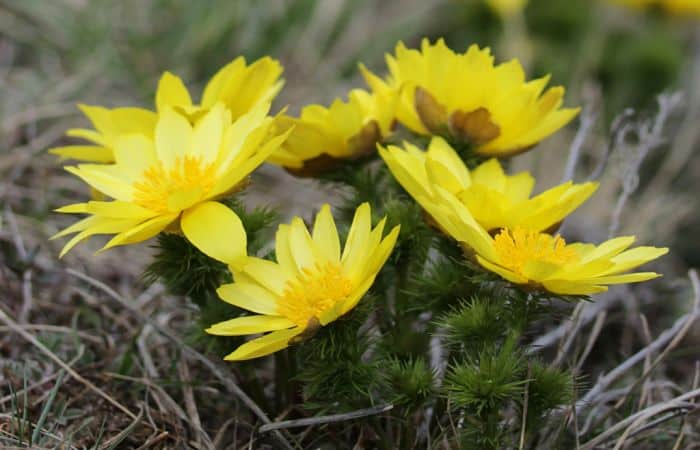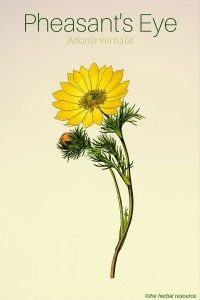Botanical Name: Adonis vernalis.
The plant genus that pheasant’s eye belongs to is named after Adonis, a young man of great beauty which according to Greek mythology was loved by the goddess Aphrodite.
When he was killed by a wild boar it caused Aphrodite great sorrow and according to legend, her tears were transformed into the beautiful pheasant’s eye flowers.
Other Common Names: Spring adonis, false hellebore, spring pheasant’s eye, sweet vernal, ox-eye, arontorpsros. (Swedish), ojo de perdiz (Spanish), adonis du printemps (French), Frühlings-Adonisröschen (German), troldøje (Danish), våradonis (Norwegian), kevätruusuleinikki (Finnish).
Habitat: Pheasant’s eye has its native range from the Black Sea and to the east through southern Siberia and towards the Altai mountains in central Asia.
The plant is also found in grassy mountainous areas in the south of Germany and Central and Eastern France.
It is often cultivated as an ornamental plant and thrives best in dry calcareous and well-drained soil in semi shade or full sun.
Pheasant’s eye is a rare plant in most of its native range and it is, therefore, legally protected from foraging in most countries.
Plant Description: Pheasant’s eye is a perennial plant that belongs to the buttercup or crowfoot family (Ranunculaceae). It grows to 20 to 30 cm (8 to 12 inches) in height with light green leaves and smooth stems.
The beautiful yellow flowers are hermaphrodite (have both male and female organs) and are pollinated by bees, flies, and beetles. The plant is self-fertile.
The flowers turn constantly toward the sun and close every night. They stay also closed in cloudy and rainy weather. The plant is in bloom from March to May, and the seeds usually ripen from May to June. The seeds are spread by ants.
Pheasant’s eye is a very beautiful and distinctive plant when it is in flower, and the finely divided foliage makes the plant easy to recognize even when not in bloom.
Plant Parts Used: The above ground parts of the plant, apart from the leafless lower part of the stem, are used in herbal medicine.
The plant material is harvested every third year when the plant is in flower. The plant material should be spread in a thin layer and dried quickly at temperatures of 50-60 ° C. During the drying the plant parts should be carefully turned several times.
Due to the herb’s toxicity, the collected material should be kept separated from other plants during the drying process.
The dried herb is odorless and used in tinctures and liquid extracts. The herb must be stored in containers with a tight lid to protect it from light and moisture. The herb has a poor shelf life, and the stocks should be renewed every year.
Most of the herb used in herbal medicine comes from Eastern Europe and Russia.
Therapeutic Benefits, Application and Properties of Pheasant’s Eye
Active Ingredients and Substances: Adonis vernalis contains a variety of cardiac stimulating glycosides (cardenolides), in concentrations ranging from 0.2 to 0.5%.
It also contains cymarin as the main active substance, small amounts of adonitoxin, flavonoids and 26 other cardenolides.
A Herb for the Heart and Cardiovascular System
Pheasant’s eye contains cardiac glycosides that are similar to those found in common foxglove (Digitalis purpurea). These substances improve the effectiveness and performance of the heart while at the same time lowering the heart rate.
The herb is considered helpful as a remedy for impaired heart function, mitral stenosis (narrowing of the heart’s mitral valve) and edema (swelling due to excess fluid buildup) caused by heart failure or poor blood circulation.
Unlike foxglove, pheasant’s eye has a mild sedative effect on the heart, and the herb is usually prescribed when the heart beats too quickly or irregularly. The effect is faster than using foxglove but more short-lived.
Since pheasant’s eye is less toxic than foxglove and as the herb does not accumulate in the body as much as foxglove does, the herb can be used over a long period of time. However, the practical application of it is somewhat limited, as its substances are absorbed in an uneven manner.
Other Medicinal Uses
The herb is regarded to have diuretic, sedative, antiarrhythmic, cardiotonic and vasoconstriction properties
Pheasant’s eye has a long history of use as a medicinal herb and it is still included in the Pharmacopoeias (an official publication containing a list of medications) of many European countries.
In the past, the herb was used as a folk medicine for sexually transmitted diseases, fever, menstrual pain, bladder and kidney stones, epilepsy and intestinal worms.
Today, it is often used in the treatment of low blood pressure and due to its diuretic action it can be useful as a remedy to counter water retention (edema). The herb has also been used as an anti-epileptic drug and it is thought to be effective against rheumatism.
The German Commission E Monographs, a governmental regulatory agency that was founded in 1978, approves pheasant’s eye for arrhythmia, and heart palpitations due to anxiety.
The herb is included in a homeopathic remedy called Adonis that is used as a treatment for angina.
Dosage and Administration
When the herb is used to treat cardiovascular diseases, it is done in the form of standardized powder, or to less extent as a tincture. The doses must be accurate to avoid adverse side effects.
The average dose of the powder is 0.6 g. According to the German Commission E, single doses should not exceed 1 g and the maximum daily dose is 3 g.
Pheasant’s eye should never be used for self-medication. The herb or any substances extracted from it should only be used under the guidance of a professional health care provider and then only in the form of standardized ready-made preparations.
Side Effects and Possible Interactions of Pheasant’s Eye
Pheasant’s eye is toxic, even in relatively small doses. The herb can cause vomiting and diarrhea in small amounts and in large amounts it can paralyze both the heart and blood vessels.
Supporting References
Bown, Deni: The Royal Horticultural Society New Encyclopedia of Herbs & Their Uses. London, Dorling Kindersley 2002.
Hensel, Wolfgang: Medicinal Plants of Britain and Europe. London, A&C Black Publishers Ltd. 2008.
Príhoda, Antonín, Ladislav Urban & Vera Nicová: The Healing Powers of Nature. Leicester, Blitz Editions 1998.
Stuart, Malcolm: The Encyclopedia of Herbs and Herbalism. London, Orbis Publishing 1979.
van Wyk, Ben-Erik & Michael Wink: Medicinal Plants of the World. Portland, Oregon, Timber Press 2004.
Volák, Jan & Jiri Stodola: The Illustrated Book of Herbs. London, Caxton Editions 1998.
Williamson, Elisabeth M.: Potter’s Herbal Cyclopaedia. Essex, Saffron Walden 2003.
Thordur Sturluson
Latest posts by Thordur Sturluson (see all)
- What is the Difference Between Hemp and Marijuana? - June 3, 2019


Leave a Reply